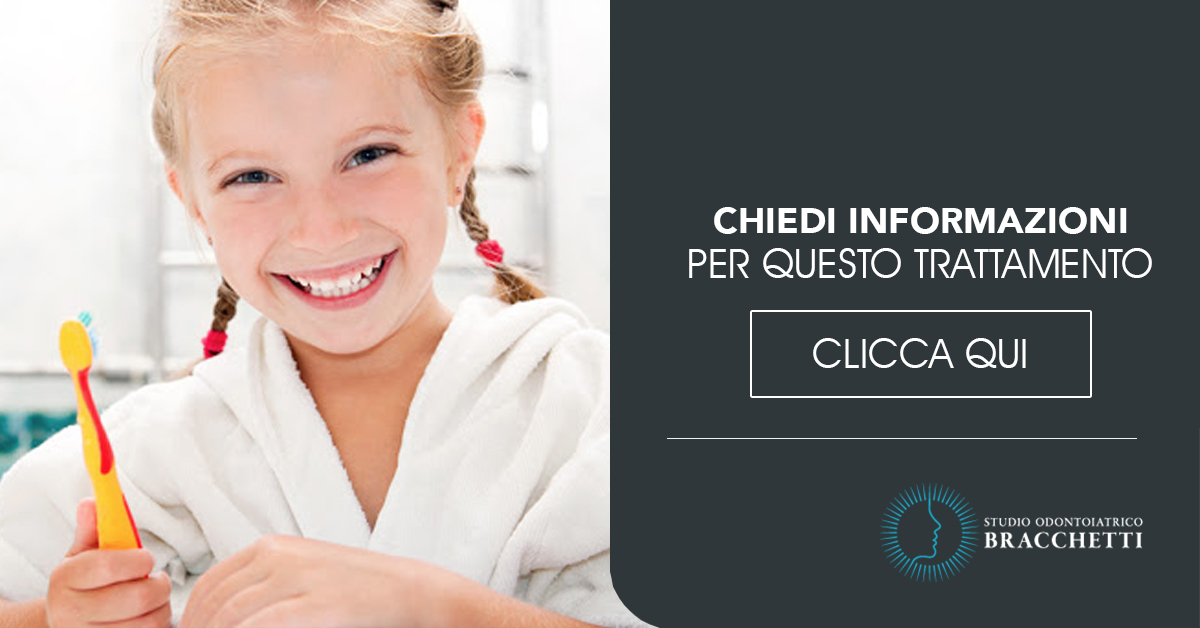Oral hygiene and Fluoroprophylaxis
Enamel is the tooth's protective shield; strong enamel is the main weapon against the development of caries. Saliva takes about 20 minutes to neutralize acids and protect teeth. Consuming candies and sweets throughout the day makes the action of saliva insufficient and increases the exposure of the teeth to acid attack, which corrode the enamel and give rise to caries.
The ideal would be not to eat more than 5 meals a day.
In recent years, artificial sweeteners have been tested, such as Xylitol and Sorbitol and substituted for Sucrose in candies, chewing gum, soft drinks, drugs, snacks, etc.
The use of these substances reduces the risk of tooth decay, but there is still a big question mark about any harmful effects on the body. The advice is to get the child used right away not to sweeten foods, not even with honey or artificial sweeteners. In this way, the child is educated not to like being too sweet, a habit that will remain even in adulthood.
WHEN TO CLEAN YOUR TEETH? After meals, bacteria begin to produce acids that corrode the teeth. For this reason it is very important to brush your teeth after each meal to remove food debris.
Some advice for proper oral hygiene.
- Brush your teeth AT LEAST twice a day, morning after breakfast and evening after dinner
- Choose a toothbrush with soft bristles, small head and handle suitable for the child's hand
- Apply a small amount of toothpaste, equal to the size of a pea, to the toothbrush
- Brush all surfaces of the teeth. Always use the same order to avoid forgetting to clean some teeth
- Use plaque detectors to motivate and teach your child how to brush teeth
- Be consistent and entertain your child
Fluoroprophylaxis
Fluoroprophylaxis, understood as the prevention of caries through the use of fluoride, represents the cornerstone of caries prevention in children.
Fluorine, like calcium and phosphorus, is essential for the formation of teeth and bones, with which it has great affinity. The mechanical action of fluoride in the prevention of caries is twofold: on the one hand, it acts on the dental structure by strengthening the enamel, that is, combining with the minerals of the enamel creates a stronger and more resistant structure to the acid action of bacteria. On the other hand, it acts on the microorganisms present in the plaque responsible for the production of acids, inhibiting their adhesion to the enamel.
The key to achieving this result is exposure to small amounts of fluoride on a regular basis for long periods. The constant presence of dissolved fluoride levels in saliva is crucial for the remineralization of enamel in the initial stage of caries. At the same time, fluoride is capable of hindering the reproduction of plaque bacteria, this leads to a reduction in the accumulation of plaque and inhibition of the production of acids responsible for caries.
In general, the administration of fluoride to the child can take place in two ways: systemically or topically.
Systemic (oral) administration affects teeth during their development and before they erupt into the oral cavity, while topical (direct to the tooth) administration affects teeth that are already erupted. The amount of fluoride consumed daily by the child orally can vary greatly and depends on the diet and regular ingestion of fluoridated substances (milk, salt, water, tablets ...). In Italy, water fluorination, except in exceptional cases, is not carried out and drinking water contains an insufficient level of fluorine to have a protective action. Even the addition of fluoride to table salt and milk has not received positive feedback in our country. In children with a higher risk of caries, the dentist or pediatrician can evaluate the administration of drops or tablets to be associated with topical application. The age groups most at risk are children between 5 and 7 years, when the first molars erupt and boys between 11 and 14 years, when the premolars and second molars come in. Keep in mind that prolonged use of excessive quantities of fluoride can have toxic effects and create damage to the nervous and circulatory systems.
To date, the topical modality is considered more effective than the systemic one.
Topical administration of fluoride can be performed at any age with greater efficacy in children. In fact, when a tooth erupts in the oral cavity, its surface is not yet completely mineralized, the enamel is porous and the tooth is more susceptible to caries.
The application of fluoride at home is done with toothpaste or mouthwash and in children associated with a high risk of caries every 6 months with professional application, by the dentist, of gel on the teeth.
However, toothpaste remains the most important means of preventing tooth decay.
Most toothpastes contain 1000 ppm fluoride. The recommended dose is a pea-sized dose of toothpaste twice a day. Importantly, toothpaste should not be ingested to prevent fluoride from being absorbed systemically (throughout the body).
To maximize the effect, it is advisable not to rinse your teeth after brushing them to leave the fluoride on. Additionally, in children under 6 years of age, parents can apply fluoridated toothpaste with floss between the molars.
To summarize:
Whether it is toothpaste or tablets, the use of fluorinated substances must be under strict supervision by parents. A prolonged overdose in addition to creating fluorosis of the teeth, which presents with diffuse white spots, can have serious toxic effects on the entire body.
From 6 months to 6 years of age, fluoroprophylaxis can be carried out through the use of toothpaste containing at least 1000 ppm of fluoride, twice a day in a pea-size dose.
If you would like to make an appointment at the Bracchetti Dental Clinic in Milan click Request form - Or you can write us on whatsapp and if you want to talk to the secretary you can do so easily by calling the office by clicking here
















